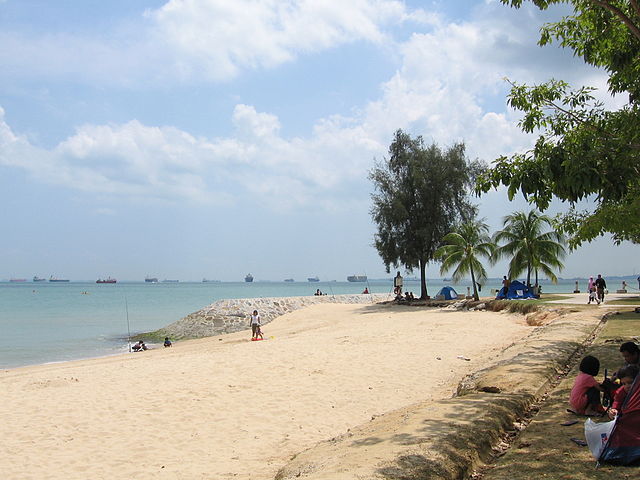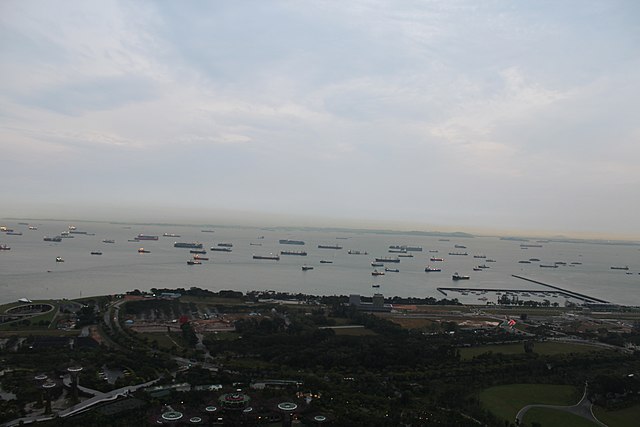Singapore Strait
Strait between Indonesia, Malaysia and Singapore From Wikipedia, the free encyclopedia
The Singapore Strait is a 113 km-long (70 mi), 19 km-wide (12 mi)[2] strait between the Strait of Malacca in the west and the South China Sea in the east. Singapore is on the north of the channel, and the Indonesian Riau Islands are on the south. The two countries share a maritime border along the strait.


It includes Keppel Harbour and many small islands. The strait provides the deepwater passage to the Port of Singapore, which makes it very busy. Approximately 2,000 merchant ships traverse the waters on a daily basis in 2017.[3] The depth of the Singapore Strait limits the maximum draft of vessels going through the Straits of Malacca, and the Malaccamax ship class.
Historical records
Summarize
Perspective


The 9th century AD Muslim author Ya'qubi referred a Bahr Salahit or Sea of Salahit (from the Malay selat meaning strait), one of the Seven Seas to be traversed to reach China. Some have interpreted Sea of Salahit as referring to Singapore,[4] although others generally considered it the Malacca Strait, a point of contact between the Arabs and the Zābaj (likely Sumatra).[5] Among early Europeans travellers to South East Asia, the Strait of Singapore may refer to the whole or the southern portion of the Strait of Malacca as well as other stretches of water.[6] Historians also used the term in plural, "Singapore Straits", to refer to three or four different straits found in recorded in old texts and maps – the Old Strait of Singapore between Sentosa and Telok Blangah, the New Strait of Singapore southwest of Sentosa, the "Governor's Strait" or "Strait of John de Silva" which corresponds to Phillip Channel, and the Tebrau Strait.[7] Today the Singapore Strait refers to the main channel of waterway south of Singapore where the international border between Singapore and Indonesia is located.
Extent
The International Hydrographic Organization defines the limits of the Singapore Strait as follows:[8]
On the West. The Eastern limit of Malacca Strait [A line joining Tanjong Piai (Bulus), the Southern extremity of the Malay Peninsula (1°16′N 103°31′E) and The Brothers (1°11.5′N 103°21′E) and thence to Klein Karimoen (1°10′N 103°23.5′E)].
On the East. A line joining Tanjong Datok, the Southeast point of Johore (1°22′N 104°17′E) through Horsburgh Reef to Pulo Koka, the Northeastern extreme of Bintan Island (1°13.5′N 104°35′E).
On the North. The Southern shore of Singapore Island, Johore Shoal and the Southeastern coast of the Malay Peninsula.
On the South. A line joining Klein Karimoen to Pulo Pemping Besar (1°06.5′N 103°47.5′E) thence along the Northern coasts of Batam and Bintan Islands to Pulo Koka.
Pilot guides and charts
Pilot guides and charts of the Malacca and Singapore straits have been published for a considerable time due to the nature of the straits[9][10][11][12]
Second World War
The strait was mined by the British during the Second World War.[13]
Incidents and accidents
In 2009, the Maersk Kendal was grounded on the Monggok Sebarok reef.[14]
In 2024, ReCAAP reported targeted stealing of engine spares by pirates as unique to the Singapore and Malacca Straits, indicating the possibility of a black market.[15]
See also
References
Further reading
Wikiwand - on
Seamless Wikipedia browsing. On steroids.

